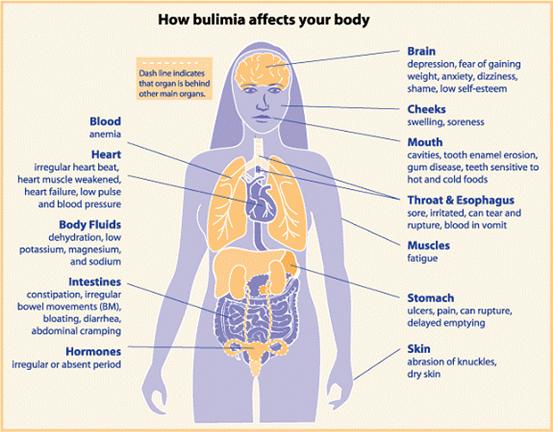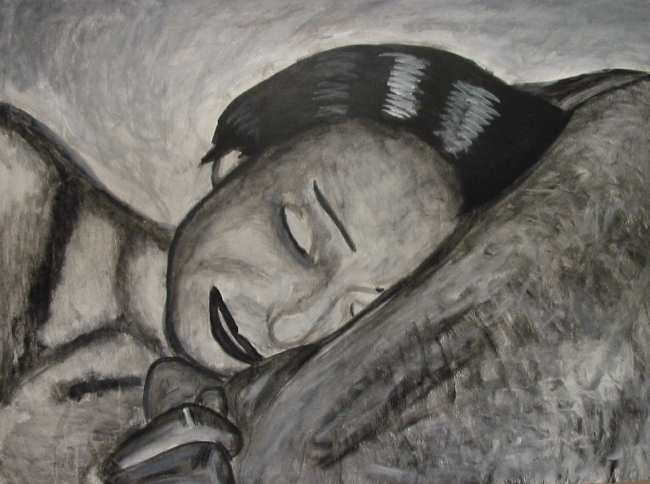 |
|||||
|
Bulimia and Depression
Mental Health and Eating Disorders
Bulimia Self HelpEating disorders are the most common mental illness during adolescence. Youngsters and teenagers are more prone to this illness which is characterized by irregular and abnormal eating habits. There are a variety of eating disorders including compulsive eating disorder, anorexia, and bulimia and binge eating disorder. Also called as compulsive eating disorder, excessive eating is found in quite a number of teenagers. This disorder is characterized by intake of food in excess quantities, which is far more than the normal requirement of the body. Teenagers with this disorder take food not due to hunger but as a means of getting rid of stress and suppressing their depression. The most noticeable change occurring due to this disorder is obesity that can lead to various other complications including heart attack, stroke and diabetes at a very early age. Another type of eating disorder quite prevalent among young girls is anorexia, dieting or avoiding food intake. A normal person’s meal is primarily divided into three parts, which include breakfast, lunch and dinner. People tend to take these meals depending upon their eating habits and appetite. However, many young girls in adolescence tend to suffer from a misconception that increased weight can only be reduced through dieting or not consuming any food. Teenagers suffering from anorexia include those who are aspiring to be models, entertainers, dancers, gymnasts, jockeys and athletes. Anorexia leads to several medical complications including growth retardation, impaired acquisition of peak bone mass, increased risk of osteoporosis, anemia and weight loss. Apart from these, anorexia can also cause potential damage to physical, emotional and mental development in adolescents. Adequate nourishment and proper supply of nutrients during childhood and adolescence is very important as it supports normal growth and developmental processes during this age. Eating disorder is a psychiatric problem that can be treated through psychological counseling and providing a balanced meal that should also include vegetables and fruits.
What is Bulimia? Bulimia nervosa is characterized by frequent episodes of binge eating, from twice a week to multiple times a day, followed by frantic efforts to avoid gaining weight. During an average binge, a bulimic consumes 3,000 to 5,000 calories in one short hour. After it ends, the person turns to drastic measures to “undo” the binge, such as taking ex-lax, inducing vomiting, or going for a ten-mile run. The key features of bulimia nervosa are:
Regular episodes of out-of-control binge eating
There are two types of bulimia, distinguished by the methods the bulimic uses to compensate for the binge eating. In the purging type of bulimia, people physically purge the food from the body by throwing up or using laxatives, enemas, or diuretics. In the nonpurging type of bulimia—which is much less common—bulimics make up for their lack of restraint by fasting, exercising to excess, or going on crash diets.
Women are much more likely than men to develop bulimia; approximately 90% of those with the disorder are female. Younger women are particularly at risk. Bulimia typically begins during the late teens or early twenties, often following a strict period of dieting or a stressful life event. DO I HAVE BULIMIA? Ask yourself the following questions. The more “yes” answers, the more likely you’re suffering from bulimia or another eating disorder.
Are you obsessed with your body and your weight?

|



|
||||
|
|
|||||
|
The binge and purge cycle
Bulimia’s destructive cycle of bingeing and purging is triggered by dieting. Driven by a desire to be thin, people with bulimia go on strict diets. But the more rigid and restrictive the diet plan, the more preoccupied they become with food. They obsess over what, when, and how much to eat, what they shouldn’t eat, and how to avoid eating. At the same time, their calorie restriction triggers physical cravings—the body’s way of asking for the nutrition it needs. Binge and Purge CycleAs the tension, hunger, and feelings of deprivation build, the compulsion to eat becomes too powerful to resist: a “forbidden” food is eaten; a dietary rule is broken. In the all-or-nothing mindset of bulimics, any slip-up is a total failure. They’ve already blown it, so they might as well let go and enjoy an all-out binge. But the enjoyment of a bingeing is soon replaced with feelings of guilt, revulsion, and self-loathing.
In an effort to regain control and make up for the excess calories eaten, most bulimics purge to make up for their bingeing. While purging is intended to counteract binge eating, it ends up reinforcing it. It’s harder to say no to temptation when you think you can avoid the consequences. “This is the last time,” people with bulimia tell themselves as they launch into a new diet. In the back of their minds, however, they know that they can always throw up, pop a water pill, or use laxatives if they lose control again. What they don’t realize is that purging doesn’t come close to wiping the slate clean after a binge. NOTE: Purging does NOT prevent weight gain Contrary to popular belief, purging isn’t very effective at getting rid of calories, which is why most bulimics end up gaining weight over time. Vomiting immediately after eating will only eliminate 50% of the calories consumed at best—and usually much less. This is because calorie absorption begins the moment you put food in the mouth. Laxatives and diuretics are even less effective. Laxatives get rid of only 10% of the calories eaten, and diuretics do nothing at all. You may weigh less after taking them, but that lower number on the scale is due to water loss, not true weight loss.
Individual Assistance Individual counselling or therapy may be more appropriate for individuals who feel overwhelmed in groups or who feel that they would benefit more from individual attention. For people whose eating problems have reached a stage of medical and/or psychological crisis, a more intensive individual approach may also be required. This approach might include hospitalization or other specialized treatment programs, accessed through a family doctor, hospital, local school, community agency or individual therapist. Group Assistance For those who feel isolated and would like to meet with others who have had similar experiences, then some kind of group assistance is often a good choice. Group therapy, support groups and self-help groups are all ways in which people can come together and, through sharing their experiences, begin to normalize their feelings and help each other deal with their difficulties. Finding bulimia treatment providers Eating Disorder Treatment Finder – Searchable directory of eating disorder treatment providers, including doctors, therapists, dieticians, and support groups. (The Something Fishy Website on Eating Disorders) EDReferral.com – Comprehensive, easy-to-search database of eating disorder and bulimia treatment providers. (The Eating Disorder Referral and Information Center)
What Are The Different Forms Of Depression?Anxiety and depression are the most often cited terms while describing the health of adolescents and teenagers. The prime reason for this is stress that develops in their little minds either due to increased expectations in academics or negligent parents or abused childhood. Apart from these, stress also builds up in teenagers due to parents who are unavailable for providing emotional support. (Right: "Fantine's Depression" by Charles Moffat, 2002.) Anxiety and stress in teenagers leads to several complications. There are many different forms of depression. Some the symptoms shown by stressed out teenagers include emotional dependence, intense aggressive behavior, shyness, compulsive eating disorder, anorexia, sleeping disorders, and a reckless attitude. However, many teenagers who are unable to cope up with the amount of stress often tend to suffer from severe depression.
Depression leads to loss in confidence, motivation and interest affecting the academic performance of the teenager. Apart from this, depression also results in building up of suicidal tendency, ‘self-mutilation’, drug abuse, alcoholism, smoking, unsafe sex and criminal activity. Some of the symptoms of depression include persistent gloominess on the face, falling academic performance and a lack of interest in performing tasks. Apart from that, depression is also associated with the symptoms mentioned for anxiety. The most appropriate treatment for reducing depression is to reduce stress. Parents should be aware of probable stress-related symptoms so as to find measures to get rid of them. Children should be encouraged to learn stress management techniques such as building relationships with family members, spending time doing communal activities, going out on a vacation, playing around with friends and being helpful to neighbors. Laughter is the best medicine to get rid of stress. One can join the nearest laughter club for this purpose. Apart from these, schools also should implement changes in their educational system so that students do not get overburdened with academic pressures.
|
|||||
 |
|
 |
|||






